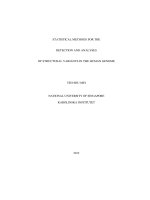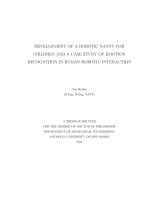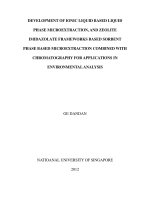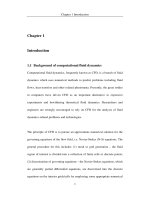Development of smoothed numerical methods for fracture analyses and interfacial toughness characterization in thin film systems
Bạn đang xem bản rút gọn của tài liệu. Xem và tải ngay bản đầy đủ của tài liệu tại đây (3.13 MB, 298 trang )
DEVELOPMENT OF SMOOTHED NUMERICAL
METHODS FOR FRACTURE ANALYSES AND
INTERFACIAL TOUGHNESS CHARACTERIZATION IN
THIN FILM SYSTEMS
CHEN LEI
NATIONAL UNIVERSITY OF SINGAPORE
2011
DEVELOPMENT OF SMOOTHED NUMERICAL
METHODS FOR FRACTURE ANALYSES AND
INTERFACIAL TOUGHNESS CHARACTERIZATION IN
THIN FILM SYSTEMS
CHEN LEI
(B.Eng., HuaZhong University of Science & Technology
M.Eng., HuaZhong University of Science & Technology)
A THESIS SUBMITTED
FOR THE DEGREE OF DOCTOR OF PHILOSOPHY
DEPARTMENT OF MECHANICAL ENGINEERING
NATIONAL UNIVERSITY OF SINGAPORE
2011
Preface
i
Preface
This dissertation is submitted for the degree of Doctor of Philosophy in the
Department of Mechanical Engineering, National University of Singapore (NUS) under
the supervision of Associate Professor, Zeng Kaiyang. To the best of my knowledge, all
of the results presented in this dissertation are original, and references are provided to the
works by other researchers. The majority portions of this dissertation have been
published or submitted to international journals or presented at various international
conferences as listed below:
The following journal papers are published or submitted based on the first objective of
the research:
1. L. Chen, G.R. Liu, N. Nourbakhsh-Nia, K.Y. Zeng, A singular edge-based
smoothed finite element method (ES-FEM) for bimaterial interface cracks.
Computational Mechanics, 2010, 45: 109-125.
2. G.R. Liu, L. Chen*, T. Nguyen-Thoi, K.Y. Zeng, G.Y. Zhang, A novel singular
node-based smoothed finite element method (NS-FEM) for upper bound solutions
of fracture problems. International Journal for Numeral Methods in Engineering,
2010, 83: 1466-1497.
3. L. Chen, G. R. Liu, Y. Jiang, K.Y. Zeng, J. Zhang, A singular edge-based
smoothed finite element method (ES-FEM) for crack analysis in anisotropic
media. Engineering Fracture Mechanics, 2011, 78(1): 85-109.
4. L. Chen, T. Rabczuk, G. R. Liu, S. Bordas, K. Y. Zeng, P. Kerfriden, Extended
finite element method with edge-based strain smoothing (ESm-XFEM) for linear
elastic crack growth. Computer Method in Applied Mechanics and Engineering,
2012, 209: 250-265.
5. L. Chen, G.R. Liu, K.Y. Zeng, A novel singular element in G space with strain
smoothing for modeling variable order singularity in composites. Engineering
analysis with boundary element, 2011, 35: 1303-1317.
6. N. Nourbakkhsh-Nia, G. R. Liu, L. Chen, Y.W. Zhang, A general construction of
Preface
ii
singular stress field in the ES-FEM method for analysis of fracture problems of
mixed modes. International Journal of Computational Methods, 2010, 7: 191-214.
7. G. R. Liu, Y. Jiang, L. Chen, G.Y. Zhang, A singular cell-based smoothed radial
point interpolation method (CS-RPIM) for fracture problems. Computers and
Structures, 2011, 89: 1378-1396.
8. Y. Jiang, G. R. Liu, Y. W. Zhang, L. Chen, A novel ES-FEM elements for
plasticity around crack tips based on small strain formulation. Computer Method
in Applied Mechanics and Engineering, 2011, 200: 2943-2955.
9. N. Vu-Bac, H. Nguyen-Xuan, L. Chen, P. Kerfriden, S. Bordas, R.N. Simpson,
G.R. Liu, T. Rabczuk, A node-based smoothed extended finite element method
(NS-XFEM) for fracture analysis. Computer modelling in engineering and
science, 2011, 1898: 1-25.
10. N. Vu-Bac, H. Nguyen-Xuan, L. Chen, P. Kerfriden, S. Bordas, R.N. Simpson,
G.R. Liu, T. Rabczuk, A phantom-node with edge-based strain smoothing for
linear elastic fracture mechanics. International Journal for Numeral Methods in
Engineering, 2011, (submitted).
The following journal papers are published or submitted based on the second objectives
of the research:
1. L. Chen, K.B. Yeap, K.Y. Zeng, G.R. Liu, Finite element simulation and
experimental determination of interfacial adhesion properties by wedge
indentation. Philosophical Magazine, 2009, 89: 1395-1413.
2. L. Chen, K.B. Yeap, K.Y. Zeng, C.M. She, G.R. Liu, Interfacial delamination
cracking shapes and stress states during wedge indentation in thin film systems-
computational simulation and experimental studies. Journal of Materials Research,
2011, 26: 2511-2523.
3. L. Chen, K.Y. Zeng, Y.W. Zhang, C.M. She, G.R. Liu, A novel method to
determine the interfacial adhesion properties by three-dimensional (3D) wedge
indentation: finite element simulation and experiment. International Journal of
Solids and Structures, 2011, (submitted).
The following journal papers are published based on other relavant works during this
research:
1. L. Chen, X. Nguyen-Xuan, T. Nguyen-Thoi, K.Y. Zeng, S.C. Wu, Assessment of
smoothed point interpolation methods for elastic mechanics. International Journal
for Numerical Methods in Biomedical Engineering, 2010, 89: 1635-1655.
Preface
iii
2. L. Chen, J. H. Li, H.M. Zhou, D.Q. Li, Z.C. He, Q. Tang, A study on gas-assisted
injection molding filling simulation based on surface model of a contained circle
channel part. Journal of Materials Processing Technology, 2008, 208: 90-98.
3. L. Chen, G. Y. Zhang J. Zhang, K.Y. Zeng, An adaptive edge-based smoothed
point interpolation method (ES-PIM) for mechanics problems. International
Journal of Computer Mathematics, 2011, 88: 2379-2402.
4. S. C. Wu, H. O. Zhang, Q. Tang, L. Chen, G.L. Wang, Meshless analysis of the
substrate temperature in plasma spraying process. International Journal of
Thermal Sciences, 2009, 48: 674-681.
5. J. H. Li, L. Chen, H.M. Zhou, D.Q. Li, Surface model based modeling and
simulation of filling processing gas-assisted injection molding. Journal of
Manufacturing Science and Engineering, 2009, 131 (011008): 1-8.
6. S. Wang, G. R. Liu, G. Y. Zhang, L. Chen, Accurate bending stress analysis of
the asymmetric gear using the novel ES-PIM with triangular mesh. International
Journal of Automotive & Mechanical Engineering, 2011, 3: 373-397.
7. L. Chen, J. Zhang, K.Y. Zeng, P.G. Jiao, An edge-based smoothed finite element
method (ES-FEM) for adaptive analysis. Structural Engineering and Mechanics,
an International Journal, 2011, 39: 120-129.
8. S. Wang, G.R. Liu, Z.Q. Zhang, L. Chen, Nonlinear 3D numerical computations
for the square membrane versus experimental data. Engineering Structures, 2011,
33: 1828-1837.
Conference Presentations (Oral):
1. L. Chen, G. R. Liu, K. Y. Zeng, A combined extended and edge-based smoothed
finite element method (es-xfem) for fracture analysis of 2d elasticity.Tthe 9th
World Congress on Computational Mechanics and 4th Asian Pacific Congress on
Computational Mechanics (WCCM/APCOM2010), Sydney, Australia July 19-23,
2010 (Presented by Lei Chen).
2. L. Chen, K. Y. Zeng, G. R. Liu, Finite element simulation and experimental
determination of interfacial adhesion properties by wedge indentation,
International Conference on Materials for Advanced Technology (ICMAT 2009),
Symposium U: Mechanical Behavior of Micro- and Nano-scale Systems,
Singapore, Jul. 28 – Jul. 2, 2009 (Presented by Lei Chen).
Acknowledgements
iv
Acknowledgements
I would like to express my deepest gratitude and appreciation to my supervisors, Prof.
Liu Gui-Rong and Associate Prof. Zeng Kai-Yang for their dedicated support and
invaluable guidance in the duration of the study. Their extensive knowledge, serious
research attitude, constructive suggestions and encouragement are extremely valuable to
me. Their influence on me is far beyond this thesis and will benefit me in my future
research. I am particularly grateful to Associate Prof. Zeng Kai-Yang, for his
inspirational help not only in my research but also in many aspects of my life especially
after Prof. Gui-Rong Liu resigned from NUS.
I would also like to extend a great thank to Dr. Nguyn Thoi-Trung and Dr. Yeap Kong-
Boon for their helpful discussions, suggestions, recommendations and valuable
perspectives. To my friends and colleagues, Dr. Zhang Gui-Yong, Mr.Wang Sheng, Mr.
Jiang Yong, Mr. Eric Li Quan-Bin, Dr. Li Zi-Rui, Dr. Deng Bin, Ms. Zhu Jing, Ms. Li
Tao, Mr. Wong Meng-Fei and Dr. Zhang Jian, I would like to thank them for their
friendship and help.
To my family, my parents and my elder sister, I appreciate their encouragement and
support in the duration of this thesis. With their love, it is possible for me to finish the
work smoothly.
I appreciate the National University of Singapore for granting me the research
scholarship which makes my study in NUS possible. Many thanks are conveyed to Center
Acknowledgements
v
for Advanced Computations in Engineering Science (ACES) and Department of
Mechanical Engineering, for their material support to every aspect of this work.
Table of contents
vi
Table of contents
Preface i
Acknowledgements iv
Table of contents vi
Summary xi
Nomenclature xiv
List of figures xvii
List of tables xxiv
Chapter 1 Introduction 1
1.1 Overview of failure modes in thin film systems 2
1.2 Numerical methods for fracture analyses in thin film systems 5
1.2.1 Cohesive zone model 6
1.2.2 Fracture mechanics-based method 7
1.2.3 Strain smoohing technique 8
1.2.4 Conclusions 10
1.3 Characterization of interfacial toughness in thin film systems 10
1.3.1 Characterization of interfacial toughness base on normal indentation 11
1.3.2 Characterization of interfacial toughness base on wedge indentation 15
1.3.3 Numerical simulations for characterization of interfacial toughness 17
1.3.4 Conclusions 19
1.4 Objectives and significance of the study 19
1.5 Organization of the thesis 22
References 24
Table of contents
vii
Chapter 2 Computational fracture mechanics in thin film systems 30
2.1 Fracture mechanics in thin film systems 31
2.1.1 Interface crack 32
2.1.2 Crack orthogonally terminating at the interface 35
2.2 Numerical methods for fracture analyses in thin film systems 36
2.2.1 Collapsed singular elements 36
2.2.2 Extended finite element method 41
2.2.3 Cohesive zone model 47
2.3 Remarks 53
References 55
Chapter 3 Fundamental theories of strain smoothing 59
3.1 General formulations 60
3.2 Classfield of smoothed models 65
3.2.1 Types of smoothing domains 65
3.2.1 Aproaches to construct the shape functions 67
3.3 Basic properties of smoothed models 71
3.3.1 Bound property 72
3.3.2 Convergence rate 73
3.3.3 Computational cost 74
3.3.4 Computational efficiency 79
3.4 Theoretical aspects of strain smoothing 81
3.5 G space 89
References 93
Chapter 4 A five-node crack-tip element in smoothed finite element method 95
4.1 Introduction 95
Table of contents
viii
4.2 Variable power singularity modeling 98
4.3 Smoothing domain construction at the crack tip 103
4.3.1 Edge-based smoothed finite element method (sES-FEM) 103
4.3.2 Node-based smoothed finite element method (sNS-FEM) 107
4.4 Weak formulation and discrete equations 112
4.5 Advantages over collapsed quadratic singular elements 114
4.6 M-integral for stress intensity factors 115
4.6.1 Interface crack 116
4.6.2 Crack orthogonally terminating at the interface 117
4.7 Numerical implementation 121
4.8 Numerical examples 122
4.8.1 Crack along the bi-material interface 122
4.8.2 Crack terminating normally at the bi-material interface 134
4.9 Application of thin film systems 141
4.10 Remarks 145
References 148
Chapter 5 A combined extended and edge-based smoothed finite element method
(ESm-XFEM) 151
5.1 Introduction 151
5.2 Methodology for coupling ES-FEM and XFEM 153
5.2.1 Selection of enriched nodes 153
5.2.2 Weak formulation of the ESm-XFEM 156
5.2.3 Numerical integration 159
5.2.4 Numerical implementation 168
5.3 Numerical examples 169
5.3.1 Edge-crack under tension 169
5.3.2 Edge-crack under shear 180
Table of contents
ix
5.3.3 Infinite plate with an inclined central crack 183
5.3.4 Crack growth simulation in a double cantilever beam 186
5.4 Remarks 189
References 190
Chapter 6 A three-dimension computational investigation of wedge indentation-
induced interfacial delamination in thin film systems 192
6.1 Introduction 193
6.2 Computational model description 195
6.3 Experimental procedure 200
6.4 Computational results 201
6.4.1 Basic model behavior 201
6.4.2 Effects of indenter length and film thickness 204
6.5 Comparison between computations and experiments 207
6.6 Stress state of interfacial delamination 210
6.6.1 A curvature-based criterion 210
6.6.2 A guideline of stress state for extracting interfacial adhesion properties 214
6.7 Remarks 218
References 220
Chapter 7 A new approach to determine interfacial toughness in thin film systems
using numerical simulation of wedge indention 222
7.1 Introduction 223
7.2 Effects of yielding in thin films 228
7.2.1 Correction factor for various plastic properties of films 229
7.2.2 Correction factor for various values of interfacial toughness 234
7.2.2 A universal expression for the correction factor
236
Table of contents
x
7.3 Effects of stress state 238
7.4 A new approach for determination of interfacial toughness 241
7.4.1 The principle of reverse analysis 241
7.4.2 Numerical verification of the reverse analysis 243
7.5 Application to low-k films on a Si substrate 245
7.6 Remarks 248
References 250
Chapter 8 Conclusions and recommendations 252
8.1 Concluding remarks 252
8.2 Recommendations for further work 256
Appendix A: M-integral for stress intensity factors 259
Appendix B: Input material properties and interfacial adhesion properties in the
model 265
Summary
xi
Summary
Thin film systems are widely used in many technologically important application
areas recently, including microelectronics and optoelectronics devices, magnetic data
storage, medical devices, and many more. However, the use of these films to enhance the
performance of engineering components is usually accompanied by the risk of failure due
to deformation, cracking or fracture in response to mechanical loads such as those arising
due to contact. A convenient approach is to use numerical methods to accurately simulate
the initial and subsequent evolution processes of these failure phenomena, for the purpose
of qualitatively characterizing the mechanical properties associated with the fracture
behaviors. In particular, an important issue in all of the thin-film/substrate systems is the
adhesion of the interface between the film and the substrate, as the interfacial failure may
lead to a system failure even though the film and the substrate have not yet failed. Hence,
the primary objectives of the present work include the follwing two parts:
1) To formulate robust and effective numerical methods for fracture analyses in thin
film systems;
2) To develop practical approaches to characterize the interfacial toughness based
on the numerical simulation of wedge indentation on thin film systems.
As the first part of this work, a stain smoothing technique is introduced to the
collapsed quadratic singular elements and the extended finite element method to
formulate two novel numerical methods for fracture analyses in thin film systems,
including the singular smoothed finite element method (sS-FEM) and the smoothed
extended finite element method (S-XFEM). Both of two proposed models possess (1) an
Summary
xii
upper-bound property in the energy release rate or J-integral, (2) super convergence, ultra
accuracy properties and high computational efficiency by combining themselves with the
strain smoothing operation if proper smoothing domains (edge based or node based) are
constructed. In addition, within strain smoothing, domain integration is transformed into
boundary integration, and the stiffness matrix calculation requires only evaluating the
shape functions values (and not the derivatives). Therefore, the singular terms of
functions as well as mapping procedures are no longer necessary to compute the stiffness
matrix, which contributes to the easy implementment in the existing codes. Further, the
smoothed bilinear form weakens the consistence requirement for the field functions, and
allows us to use much more types of methods to create shape functions. Consequently, it
inspires more new numerical methodologies which are accurate, flexible, effective and
simple. In particular,
For the sS-FEM, a novel triangular five-node (T5) singular crack-tip element is
formulated within the strain smoothed framework to model the variable power
type stress singularity in the vicinity of the crack tip. The use of such mesh setting:
one layer of T5 singular elements together with linear elements away from
singular zone, eliminates the requirement of transition elements which is present
in the tranditional T6 or T8 collapsed quadrilateral singular elements.
For the S-XFEM, the strain smoothing operation is performed on the XFEM
approxiamtation that involves both discontinuous and singular (non-polynomial)
parts, in addition to the standard continuous part. Thus, it eliminates the need to
subdivide elements cut by discontinuities (material interfaces, cracks) by
Summary
xiii
transforming domain integration into boundary integration, which is strictly
required if no special treatment is adopted in the traditional XFEM.
In the second part of this work, a three-dimensional finite element (FEM) simulation
is performed to systematically investigate the interfacial delamination cracking shapes
and the transition of stress states during wedge indentations. A straightforward criterion
based on the curvature of the delamination crack front is for the first time in this thesis
proposed to indicate the transition of stress states during the interfacial delamination, and
a guideline is proposed to classify the 2D to 3D transition for extracting the interface
adhesion properties.
In addition, a new characterization approach is proposed to extract the interfacial
toughness in thin film systems using the numerical simulation of wedge indentation
experiments. In this approach, a comprehensive finite element study is undertaken to
correct de Boer’s solutions for the measurement of wedge indented interfacial toughness,
and a universal correction expression for de Boer’s equations is obtained using a
regression method. With this expression, a reverse algorithm is proposed to extract the
interfacial toughness. The correction eliminates the small plastic zone assumption and
plane strain condition assumption that are present in de Boer’s equations, and make them
more practical for evaluation of the interfacial toughness in thin film systems. Extensive
numerical verifications are performed to show the present approach provides an accurate
evaluation for the interfacial toughness. An application of this approach to low-k
dielectric films, namely, methyl-silsesquioxane (MSQ) and black diamond (BD™) films,
on a Si substrate is also presented.
Nomenclature
xiv
Nomenclature
Problem domain
s
k
Smoothing domain
A
Area of the problem domain
s
k
A
Area of the smoothing domain
Boundary of the domain
t
Natural boundary
u
Essential boundary
b
Body force vector
t
Traction vector
δ
Sepration vector
B
Strain matrix
D
Stress-strain matrix of isotropic linear elasticity
K
Stiffness matrix
f
Force vector
n
L
Matrix of unit outward normal
n
Unit outward normal vector
E
Young’s modulus
Shear modulus
v
Poisson ratio
Nomenclature
xv
,
Dundurs bi-material parameters
1
Stress singularity order
I
K
,
II
K
Stress intensity factors
J
J-integral
G
Energy release rate
()
x
Branch functions
()H x
Heaviside jump function
Hilbert space
G space
W
2
Weakened weak form
e
N
Number of elements
node
N
Number of nodes
s
N
Number of smoothing domains
edge
N
Number of edges
()
E
Strain energy over domain
e
e
Error in energy norm
d
e
Error in displacement norm
k
e
Relative error in the stress intensity factors
g
e
Relative error in the the energy release rate
T
zyxx
Cartesian coordinates
Nomenclature
xvi
d
Displacement vector
ε
Strain vector
σ
Stress vector
i
N
Shape function component
N
Shape function vector
Smoothing function
f
E
Elastic modulus of the film
s
E
Elastic modulus of the substrate
f
h
Film thickness
s
h
Substrate thickness
n
Strain-hardening exponent
mi
W
Length of the wedge indenter
fs
W
Width and length of the substrate
h
Indentation depth
n
,
t
Normalized maximum normal separation
0
Length unit
y
Yield stress
yf
Yield stress of the film
s
Interfacial strength
0
or
i
Interfacial toughness
List of figures
xvii
List of figures
Figure 1.1
Schematic of different failure modes in thin film systems. (a) single
through-thickness crack in the coating deflects to the interface to
cause delamination, (b) multiple cracks in the film (such as picture-
frame cracks) diverting to the interface to cause delamination, (c)
delamination resulting from an edge flaw at the interface, (d)
compressive stress inbuckling in the film, (e) a crack in the substrate
divert to the interface to cause delamination.
Figure 2.1
Two classic categories of cracks in thin film systems: (a) a crack
along the bi-material interface; (b) a crack perpendicularly
terminating at the bi-material interface.
Figure 2.2
Schematic of collapsed eight-node and six-node quadratic singular
elements. The optimal position of side nodes adjacent to the crack-tip,
aL
, depends on the material properties.
Figure 2.3
Normalized co-ordinate of a quadrilateral element.
Figure 2.4
Support domain
i
w (shaded) for a nodal shape function in the
standard XFEM.
Figure 2.5
Element and node categories in the standard XFEM.
Figure 2.6
Schematic-diagram showing cohesive elements.
Figure 2.7
Schematic-diagram showing the traction-separation law used for 3D
FEM simulation: (a) single mode; (b) mixed-mode.
Figure 3.1
Division of problem domain into
s
N non-overlapping smoothing
domains
s
k
for
k
x
. The smoothing domain is also used as basis for
integration.
Figure 3.2
Illustration of smoothing domains (shaded area) in the ES-FEM.
Figure 3.3
Division of a quadrilateral element into the smoothing domains (SDs)
in the CS-FEM by connecting the mid-segment-points of opposite
segments of smoothing domains. (a) 1 SD; (b) 2 SDs; (c) 3 SDs; (d) 4
SDs; (e) 8 SDs; (f) 16 SDs.
Figure 3.4
Illustration of smoothing domains (shaded area) associated with node
List of figures
xviii
k in the NS-FEM.
Figure 3.5
Illustration of node selection schemes for the smoothed models.
Figure 3.6
Illustration of the bandwidth for the smoothed models.
Figure 4.1
Crack-tip configuration using a basic mesh of triangular elements: (a)
one layer of five-node crack-tip (T5) singular elements with one
additional node added on each edge leading to the crack-tip (called the
crack-tip edge); (b) the location of the added node is the one quarter
length of the edge from the crack-tip; (c) displacement interpolation
within a T5 crack-tip element (1-2-3-4-5): the displacement varies
with
r via the enriched form of Eq. (4.1) in the radial direction and the
variation in the tangential direction is quadratic.
Figure 4.2
Construction of the edge-based smoothing domains (ESD). Note that
shaded area indicates one layer of smoothing domains associated with
the crack-tip edges.
Figure 4.3
Division of a smoothing domain associated with the crack-tip edge
(ESD) into sub-smoothing cells: (a) 1
sc
n
; (b) 2
sc
n ; (c) 3
sc
n
.
Figure 4.4
Construction of the node-based smoothing domains (NSD). Note that
shaded area indicates one smoothing domain associated with crack-tip
node.
Figure 4.5
Division of the smoothing domain associated with the crack-tip node
(NSD) into sub-smoothing cells: (a) scheme 1; (b) scheme 2; (c)
scheme 3; (d) scheme 4.
Figure 4.6
(a) Conventions at crack-tip. Domain
d
is enclosed by
,
C
,
C
and
0
C
.Unit normal
j
j
mn
on
and
j
j
mn
on
C
,
C
and
0
C
; (b) different types of elements at the crack-tip for calculation
of the interaction integral; (c) each triangular element domain hosts
three sub-parts of smoothing domains associated with three edges,
e.g., for element domain
,
d
eff m
, three sub-parts
12
,
s
s
and
3
s
are
involved.
Figure 4.7
Crack along the bi-material interface under remote tension (half
model).
Figure 4.8
Crack along the bi-material interface: meshes in the vicinity of the
crack-tip with / 8.0
c
ah (
1, 30
aW
).
List of figures
xix
Figure 4.9
Crack along the bi-material interface: study of effect of the schemes
of smoothing domain for sNS-FEM.
Figure 4.10
Bound property: convergence of the normalized
I
K
for centre-crack
with bi-materials under tension.
Figure 4.11
Bound property: convergence of the normalized
II
K
for centre-crack
with bi-materials under tension.
Figure 4.12
Bound property: convergence of the normalized J-integral for centre-
crack with bi-materials under tension.
Figure 4.13
Convergence rate in term of energy norm for the problem of a crack
along the bi-material interface under remote tension.
Figure 4.14
Comparison of computational efficiency in term of energy norm for
the problem of a crack along the bi-material interface under remote
tension.
Figure 4.15
Crack terminates normally at the interface under uniform pressure on
the crack faces.
Figure 4.16
Crack terminates normally at the interface: (a) meshes of the whole
discretized model; (b) meshes in the vicinity of the crack-tip with
/100
c
ah
.
Figure 4.17
Crack terminates normally at the interface with material
1
-material
2
of
epoxy-aluminum: logarithmic stress distributions along the radius
path of
o
45
.
Figure 4.18
Crack terminates normally at the interface with material
1
-material
2
of
aluminum-epoxy: logarithmic stress distributions along the radius
path of
o
45
.
Figure 4.19
Crack terminates normally at the interface under mix-mode loads.
Figure 4.20
Schematic-diagram of a film/substrate system by four point bending
test (half model).
Figure 5.1
Construction of edge-based strain smoothing domains and support
domain
i
w
(shaded) for a nodal shape function in the ES-FEM.
Figure 5.2
Illustration of edge-based smoothing domain (sd) and node categories
in the ESm-XFEM in terms of the support domain of nodal shape
functions.
List of figures
xx
Figure 5.3
Generation of subpolygons for quadrature of the XFEM in: (a) those
elements cut by a crack. The polygons (b) formed from the
intersection of the crack and the element geometries are triangulated
as in (c) to create the element sub-elements.
Figure 5.4
Partition of split smoothing domains (sd) in the ESm-XFEM. The
decomposition of polygonal domains (sub-sd1 and sub-sd2) into
triangles is not necessary. Integration is performed on the boundary of
sub-sd1 and sub-sd2 instead. The bold line represents the elements,
and the dashed line denotes the boundaries of smoothing domains.
Figure 5.5
Partition of tip smoothing domains (sd) in the ESm-XFEM. Note that
sub-sds and sub-cells do not carry any degrees of freedom and are
solely used for smoothing and numerical integration.
Figure 5.6
Division of a sub-smoothing domain in to sub-smoothing cells: (a)
1
sc
n
; (b)
2
sc
n
; (c)
3
sc
n
; (d)
4
sc
n
; (e)
6
sc
n
; (f)
8
sc
n
.
Figure 5.7
Plate with an edge crack under tension.
Figure 5.8
Meshes in the vicinity of the crack (seed points:
25 50
) (a) 3-nodal
triangular elements; (b) 4-nodal quadrilateral elements.
Figure 5.9
Convergence rate in term of energy norm for the problem of a plate
with an edge crack under remote tension.
Figure 5.10
Convergence rate in term of mode I SIF
I
K
for the problem of a plate
with an edge crack under remote tension.
Figure 5.11
Comparison of computational efficiency in term of energy norm for
the problem of a plate with an edge crack under remote tension. Note
that, the ESm-XFEM produces error approximately 1/1.7 times as
much as the XFEM
-1.16
0.21
-1.31
XFEM 10
10 1.7
ESm-xfem10
, at a computation
time of about
0.4
10
.
Figure 5.12
Comparison of computational efficiency in term of mode I SIF
I
K
for
the problem of a plate with an edge crack under remote tension. Note
that the ESm-XFEM produces about 1/2.1 times error as much as the
XFEM
-1.81
0.3
-2.11
XFEM 10
10 2.1
ESm-xfem10
, at a computation time of about
0.4
10
.
List of figures
xxi
Figure 5.13
Plate with an edge crack under shear.
Figure 5.14
Convergence rate in term of energy norm for the problem of a plate
with an edge crack under remote shear. Notice the lower error level
and quasi optical convergence rate are provided by the ESm-XFEM
compared to the standard XFEM, despite the absence of geometrical
enrichment.
Figure 5.15
Infinite plate with an inclined central crack under tension.
Figure 5.16
Meshes in the vicinity of the crack (
/14.4ah
).
Figure 5.17
Geometry and loads for the double cantilever beam.
Figure 5.18
Double cantilever beam: comparison of crack path after 20 steps using
the standard XFEM and the ESm-XFEM for two initial perturbations
at the crack tip:
d
= 1.43° and
d
= 5.71°.
Figure 6.1
Schematic-diagram showing the geometries and material parameters
of the wedge indentation on a film/substrate system. The coordination
system is indicated in the diagram, and
h denotes the indentation
depth.
Figure 6.2
The three-dimensional finite element mesh used in the simulations.
Figure 6.3
The film deformations and crack front profiles with / 0.5
syf
,
00
/( ) 0.006
yf
,
0
/2.0
mi
W
and
0
/0.5
f
h
at indentation
depth of 0.8
f
hh : (a) 2D plane strain condition with
mi fs
WW ; (b)
3D stress state with
mi fs
WW ; (c) distribution of plastic strain in the
region near the indenter.
Figure 6.4
Indentation load-depth curves for a range of wedge indenter lengths
with a fixed film thickness of
0
/0.5
f
h .
Figure 6.5
Indentation load-depth curves for a range of film thicknesses with a
fixed wedge indenter length of
0
/2.0
mi
W .
Figure 6.6
Comparison of crack front profiles from the experiments and
simulations for the wedge indentations with two different length of
the wedge indenter tip on the same film.
Figure 6.7
Comparison of crack front profiles from the experiments and
simulations for different film thicknesses with the same wedge
List of figures
xxii
indenter tip.
Figure 6.8
Schematic-diagram showing the curve fitting for the crack front
profiles.
Figure 6.9
The crack front contours at different normalized indentation depths,
/
f
hh.
Figure 6.10
The curvature of crack front versus normalized indentation depth at
different lengths of the wedge indenter tips.
Figure 6.11
The curvature of crack front versus normalized indentation depth for
the thin films with different film thicknesses.
Figure 6.12
The curvature of crack front versus ratio of wedge tip length to film
thickness.
Figure 6.13
Comparison of curvature of crack fronts from the experiments and
simulations versus ratio of wedge indenter length and film thickness.
Figure 7.1
Schematic-diagram showing a typical interfacial delamiantion process
by wedge indentation. The geometries and material parameters of
wedge indentation on a film/substrate system are indicated in the
diagram, and the origin of coordination system is the center of the
bottom surface of the system.
Figure 7.2
Dimensionless function
1
defined by Dao et al. constructed for a
wedge indentation on soft-film-hard-substrate systems with
/1.0
f
ht . A representative strain 3.3%
r
is identified which
makes the dimensionless function
1
independent of the strain
hardening exponent
n.
Figure 7.3
Correction factor
vs. normalized indentation depth /
f
ht for
various strain hardening exponent values (
0.1, 0.25, 0.4n
).
Figure 7.4
Correction factor
vs. normalized indentation depth
/
f
ht
at a fixed
normalized interfacial toughness
3
0
/3.7510
irf
for various
normalized film representation stress
*
/
rf f
E
.
Figure 7.5
Correction factor
vs. normalized indentation depth /
f
ht with a
fixed
*
/
rf f
E
2
1.50 10
and a range of values of normalized
interfacial toughness
0
/
irf
.
List of figures
xxiii
Figure 7.6
Regression surface of the correction factor
vs. two independent
variables: the logarithmic inverse normalized representative stress
*
In( / )
frf
E
, and the logarithmic normalized interfacial toughness
0
In( )/
irf
.
Figure 7.7
Variation of the correction factor
with the ratio of indenter length
to film thickness, /
wf
lt.
Figure 7.8
Schematic-diagram showing the flow chart for determining the
interfacial toughness by using reverse analysis algorithm.
Figure B.1
P-h curves before interfacial delamination occurred for BD/Si system.
While open and closed triangle symbols represent the simulated and
experimental curves of 120
o
wedge indentation, respectively. Open
and close square symbols represent the simulated and experimental
curves of 90
o
wedge indentation, respectively.
Figure B.2
Interface energy-strength contour plot of the variation of normalized
90
c
P
and
120
c
P
for the BD/Si system (solid lines:
90
0
/( )
cyf
P
and
dashed lines:
120
0
/( )
cyf
P
(
m).
Figure B.3
BD/Si system’s interface energy-strength contour for 90° and 120°
wedge indentation showing the intersections of
P
c
90
/(σ
yf
Δ
o
) = 5.16 –
5.18µm and
P
c
120
/(σ
yf
Δ
o
) = 6.58 – 6.92µm. Full lines represent the
contour for
P
c
90
/(σ
yf
Δ
o
), while dashed lines represent that for P
c
120
/(σ
yf
Δ
o
).









